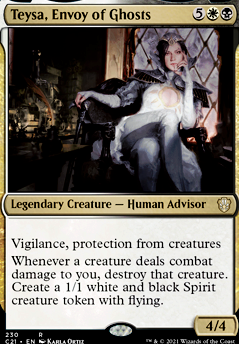And boy howdy, this is our largest category. As mentioned previously, much of this deck’s strength comes from being able to answer most threats at a moment's notice, while gaining incremental value with our own. I've broken it down into smaller categories for ease of navigation, and so if you decide to build the deck on your own, it's easier to adjust the amount needed for your personal meta.
For Creatures
Teysa, Orzhov Scion
: Though her removal price is steep, baby Teysa provides her own fodder when our black creatures die - and we make sure they do a lot of that. She also synergizes well with general Teysa, whose tokens are both white and black.
Swords to Plowshares
/
Path to Exile
: Best creature removal in the format, likely in all of Magic. One mana, gets around indestructible and other reanimation decks, and the value your opponents get in return is negligible over the course of a long game.
Mortify
: Can also hit a pesky enchantment, but usually we'll end up using this on a creature. A little flexibility for a little more mana.
Dictate of Erebos
: This card has an interesting effect of also protecting our creatures, as opponents will be reluctant to destroy them unless they have fodder to ditch. We have the tools to abuse Dictate very effectively, as we already sacrifice our own creatures for value - now it will pull double duty by getting rid of anything our opponents' try to play as well. Finally, flash adds from great flexibility, as you can turn a one-sided boardwipe or some chump blocking into a blowout.
Other / Any Target
Anguished Unmaking
/
Utter End
: Efficient and comprehensive answers to any threat.
Archon of Justice
/
Ashen Rider
: Similar to above. Both cards are strong in any deck, but especially strong in ours due to our ability to sacrifice either for instant-speed, no-mana (or almost no mana) removal. On decently-sized, evasive bodies, both creatures can also get in a bit of damage or protect us from attackers while waiting on the battlefield for their target. Ashen Rider can be expensive to cast, but the benefit of being a reanimation deck is you should only have to pay for it once before you begin looping with other spells.
Aura of Silence
: 3 mana to remove an artifact/enchantment is a fine deal even if you have to sacrifice it right away. Otherwise, it sits on the battlefield and makes it harder for opponents to cast their valuable spells (both through taxation and fear of anything scary being immediately removed) until the right target comes along. This card on curve
Graveyard
Kalitas, Traitor of Ghet
: Prevents opponents' most important card type from ever hitting the graveyard, denying them both death triggers and the chance to ever return them. The zombies are a nice extra benefit; they usually end up as chump blockers that grow Kalitas or sacrifice fodder for cards like
Yahenni, Undying Partisan
.
Leyline of the Void
: One of the best graveyard checks in the game. It’s a hard permanent type to remove, doesn’t hold back our own reanimation strategy, and sometimes we get it for free in the very beginning.
Bojuka Bog
: Instant nuke of one person's entire graveyard, for those spellslinger decks running
Past in Flames
, or other reanimators like
Muldrotha, the Gravetide
. Entering tapped is a fine price to pay, even though you'll occasionally have it in your opener or draw it early for little to no value.
Boardwipes
Fumigate
: 5CMC white boardwipe like so many of those WotC has been fond of printing the last few years. Not as good as
Wrath of God
or
Damnation
, but since I don't have a copy of either for this deck, one extra mana for a bit of lifegain is a fine price to pay.
Hour of Revelation
: In multiplayer, your opponents will have to try very hard to get this card to cost more than . Triple white can be a bit daunting in early turns, but it comes with the benefit of hitting everything on the board - this levels the playing field, especially against artifact or superfriends strategies trying to do unfair things. It can set us back a few turns since it hits our mana rocks, but it's going to do the same to any non-green deck, so our opponents are at least experiencing the same problem.
Black Sun's Zenith
: Can be a bit expensive to cast, and you may not be able to hit absurdly large creatures like those in a +1/+1 counter deck, but gets around indestructible and regeneration. You can also get cute with
Mikaeus, the Unhallowed
by casting for 1 to remove the +1/+1 counters on your creatures that have already gotten the benefit of undying. Finally, it shuffles back into the deck to potentially use again (extra value!).
Merciless Eviction
: Another boardwipe that gets around indestructible and regeneration, as well as hosing other reanimation decks by exiling creatures instead of putting them in the graveyard. However, this card's real value is in its flexibility, as we can just as easily choose artifacts or enchantments to punish the
Sharuum the Hegemon
or
Bruna, Light of Alabaster
players at the table. Enchantress and artifact-reliant strategies often have a hard time recovering from this card targeting their favored permanent type. If choosing creature-mode, it's beneficial to try to sacrifice as many dudes of our own as possible before we cast this - that way our creatures end up in our graveyard for later use, while our opponents' are removed for good.
Phyrexian Scriptures
: The deck wanted one more board wipe to cross into the realm of true control, but sweeper #5 can definitely afford to be a little weird. Scriptures is an interesting card that lets us keep our best creature, and follows it up by hosing opposing graveyards so no one else can get their cards back. Though it does sit vulnerable on the battlefield for a turn (and doesn't allow us to cast other spells before firing in our first main phase), generally we're okay with opponents using their removal on this card rather than one of our other, stronger pieces.







